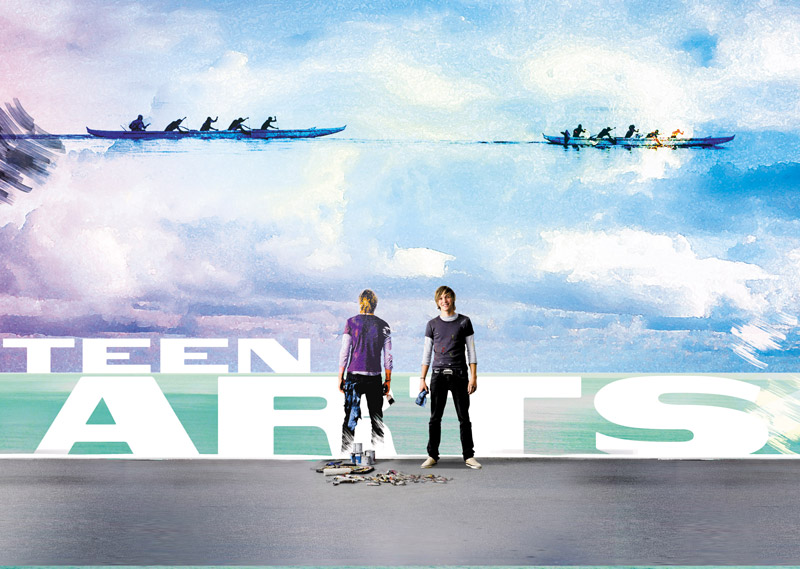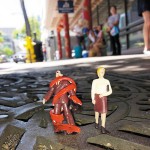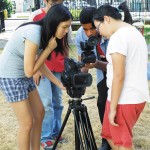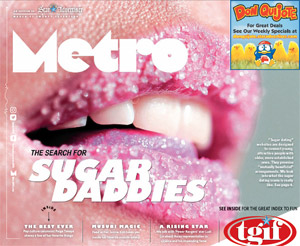Teen Arts

The above image is a photo composite for illustrative purposes only and does not accurately reflect final artwork
After years of running an after-school arts program for teens, The ARTS at Marks Garage executive director Rich Richardson can rattle off a handful of success stories on cue. There’s the spoken word student who went on to perform at the White House for President Obama. There’re the film students whose works were selected to screen at the Hawaii International Film Festival. There’s the girl who discovered a love for design and went on to work for Apple.
According to Richardson, the Teen ARTS at Marks program often has helped students discover passions — and viable careers, even — in creative industries, with a specific focus on students who might not otherwise have art programs available to them.
“It’s awesome to find something that you love, and then follow that path, instead of what you might feel like you have to do,” Richardson says.
For more than a decade, the Chinatown-based arts center has been offering courses for students ages 13 to 19, many of whom are residents of the Chinatown area or nearby neighborhoods. Classes have included a myriad of art forms — ukulele, pottery, documentary filmmaking, photography — taught over 10-week sessions.
And with its upcoming session, the Teen ARTS at Marks program is going to new heights — literally, as students will be working alongside a set of mentor artists — Solomon Enos, Noelle Kahanu, Meleanna Meyer and Carl Pao — to create towering 30-foot backdrops for upcoming musical performances at Hawaii Theatre; and figuratively, too, as the session entails a collaboration between well-known local artists and musicians, as well as the kids, a first for the program.
- miniature sculpture making
- Past Teen ARTS at Marks courses have included miniature sculpture making and filmmaking
Aptly titled Big Time — in reference to the big-name artists and musicians, and those large murals — the session kicks off during fall break, from Oct. 5 to 9, and then continues after school through mid-December. Throughout the course, students will have the opportunity to work with each of the mentor artists, while creating murals for four Hawaii Theatre shows: The Rough Riders on Oct. 23, Makana Nov. 14, Amy Hanaiali‘i and Willie K Dec. 18-20, and Kuana Torres Kahele Jan. 10.
“These kids have the opportunity to see something they create manifested on stage — and that is just chicken-skin exciting,” says Hawaii Theatre director of programming John Parkinson.
The Value of Arts Education
“The idea is to give (students) an opportunity that they don’t get in a normal school setting,” Richardson explains of the Teen ARTS program.
“There is a real engagement that happens through the arts that doesn’t happen when you are taking a math quiz,” he adds.
And although arts education may be deemed superfluous during times of tightening school budgets, Richardson argues that it has the power to cultivate problem-solving skills that are valuable to business innovation, tech or, really, any industry.
“That is kind of the ground rule of making an artistic project happen — constant problem solving,” Richardson says. “It’s an exercise in being creative with the resources you have.”
It’s a sentiment that’s backed by research. Numerous studies have linked arts education with high test scores and overall academic success. A 2012 report by the National Endowment for the Arts also asserts arts education is consistent with lower student drop-out rates and higher levels of participation in community service.
A Broader Impact
Many of the Teen ARTS courses feature elements that are designed to get the students interacting with nearby professionals, residents and businesses — as a way to strengthen the community, as well as simply to familiarize students with the area and the people who inhabit it.
“It is about getting to know Chinatown better, deeper, in a different way through different lenses,” Richardson says.
“It is about them learning to explore their surroundings, evaluate the situations,” adds Christie Knoll, an arts educator who leads Teen ARTS courses.
She adds that the purpose of the “program isn’t to make every child a professional artist, but merely to supply opportunities for learning, exploring and connection with the community.”
In one session on documentaries, for instance, kids interviewed older local merchants to talk with them about their experiences. In another recent course, students crafted miniature sculptures — and then placed them surreptitiously throughout Chinatown, with the hopes that they would bring a little joy to anyone who happened to stumble upon them. A fun, simple project on the surface, the subtext was about learning to control your environment and altering your perception of what you can and cannot change.
“It was kind of a humorous intervention in your walk across Chinatown,” Richardson says. “I think sometimes it can be seen as a sad place, with people down and out … The lesson (was) that if you can control your environment even (here), you can control your environment anywhere, at any time, later in life.”
A Community Collaboration
Richardson envisions The ARTS at Marks Garage “almost like a park for people to connect and create together.”
Much of his work has been about building up and supporting the Chinatown arts community. In addition to running the center, he also is credited as being one of the founders of Chinatown’s First Fridays and oversees Chinatown Artist Lofts. Richardson envisions ARTS at Marks as a center that is a “revolving door… and an integral part of the tapestry of the neighborhood.”
In that spirit, many of the kids who enroll in the Teen ARTS program come from Chinatown, or nearby public housing.
“It’s about equitable development and making an organic arts scene based on the materials we find here, which are our neighbors and our neighborhood as a kind of canvas,” Richardson says.
The Big Time session — with collaborations taking place among the musicians, the artists and the students, as well as between Hawaii Theatre and The ARTS at Marks — is perhaps especially emphatic on this idea of strengthening the community through the arts.
The session itself was born from conversations between Richardson and Parkinson about art and community.
“It’s been a conversation about downtown, about music, about art — and where do those all intersect, what does it look like, does it mean anything?” Parkinson explains.
After a beat, he answers his question: “I’m not sure … It will be answered by what the people going to the show take away from the collaboration … And it will be answered, maybe, by what the kids feel about it after they have been to the concert and see their work.”
The next Teen ARTS at Marks session, Big Time, runs from 10 a.m. to 4 p.m. Oct. 5-9. After fall break, the session runs from 3:30 to 5:30 p.m. Tuesdays and Thursdays through Dec. 10. Registration packets currently are available at the front desk at The ARTS at Marks Garage during its business hours from noon to 5 p.m. Tuesday-Saturday.
For more information on the program, visit artsatmarks.com. For more on Hawaii Theatre’s upcoming performances, visit hawaiitheatre.com.



